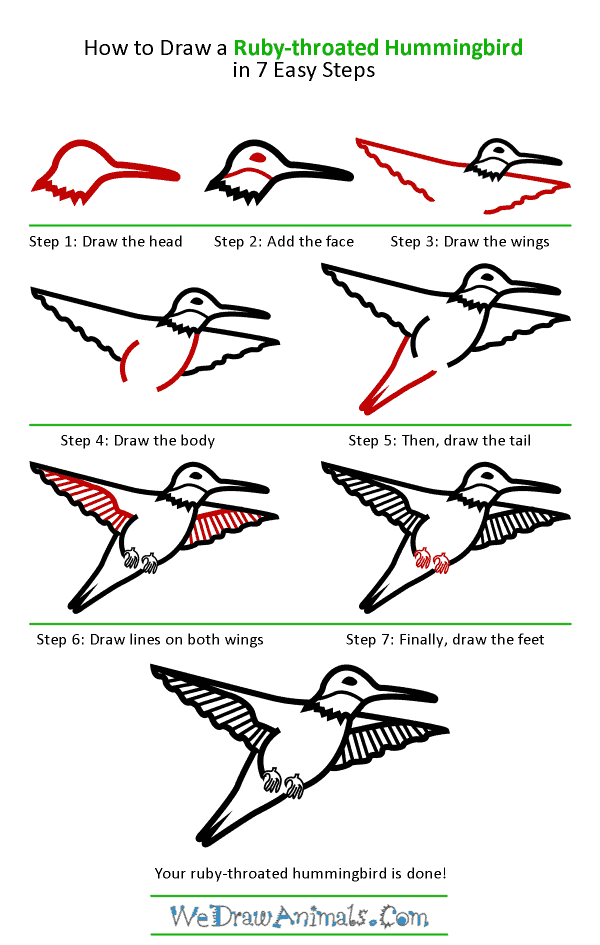In this quick tutorial you'll learn how to draw a Ruby Throated Hummingbird in 7 easy steps - great for kids and novice artists.
The images above represent how your finished drawing is going to look and the steps involved.
Below are the individual steps - you can click on each one for a High Resolution printable PDF version.
At the bottom you can read some interesting facts about the Ruby Throated Hummingbird.
Make sure you also check out any of the hundreds of drawing tutorials grouped by category.
How to Draw a Ruby Throated Hummingbird - Step-by-Step Tutorial
Step 1: Draw the head, which is a dome shape like other small birds, but with a long, narrow beak unlike most. The bottom of the head should be jagged to show the tuft of feathers where the neck meets the body.
Step 2: Add the face by drawing a large circle for the eye and a curved line below the beak to show the hummingbird’s plumage.
Step 3: Draw the wings. You can imagine a triangle with the longest side going across the body of the bird, with the smaller sides drawn as wavy lines to look like the ends of the wing feathers. Hummingbirds beat their wings much faster than other birds and have distinct wings designed for this.
Step 4: Draw the body using two bowed lines, with one from the neck down past the wing, and another shorter one for the back, past the wing.
Step 5: Then, draw the tail. Use a long diagonal line tapering down from the bottom of one wing and another coming down from the body of the bird, forming a sharp V-shape.
Step 6: Draw a series of lines on both wings to show the feathers.
Step 7: Finally, draw the feet, which are small and at the end of very short legs.
Interesting Facts about the Ruby-throated hummingbird
The ruby-throated hummingbird is a type of hummingbird that can be found in eastern America or south America depending on migration patterns. Most commonly these birds can be found near the Mississippi river. As the name of this bird states, the male RT hummingbird has a beautiful, vibrant color that covers the whole throat area, made even more striking by the contrast of its black face and chin. The female, which is larger than the male, have a white chin and throat.
Did you know?
- When you hear the hum of a hummingbird, what you are actually hearing is the sound of their wings flapping incredibly fast, with the RT hummingbird being able to flap its wings up to 53 beats per second
- Hummingbirds make a huge impact in the life of flowers as they are a huge pollinators while visiting many flowers to eat food that is twice their own body weight
- When it is spring, the adults and juvenile hummingbirds will lose all of their feathers to regrow new ones
- Though forests are the common area to live for hummingbirds, they are often easy to find near gardens or other areas where there are many flowers and plants for them to collect nectar
- This species of hummingbird is the only hummingbird that breeds in the eastern area of north America








